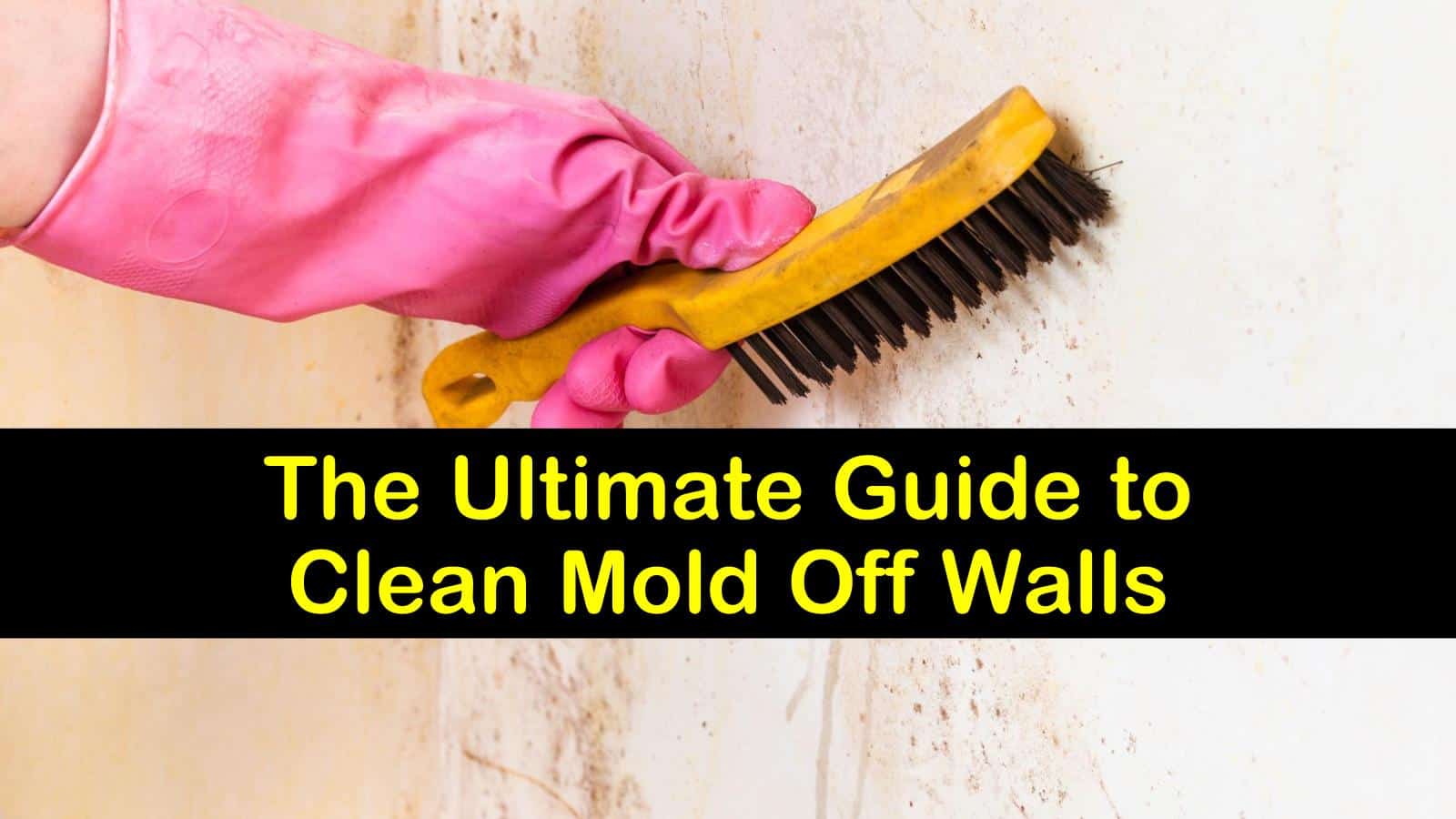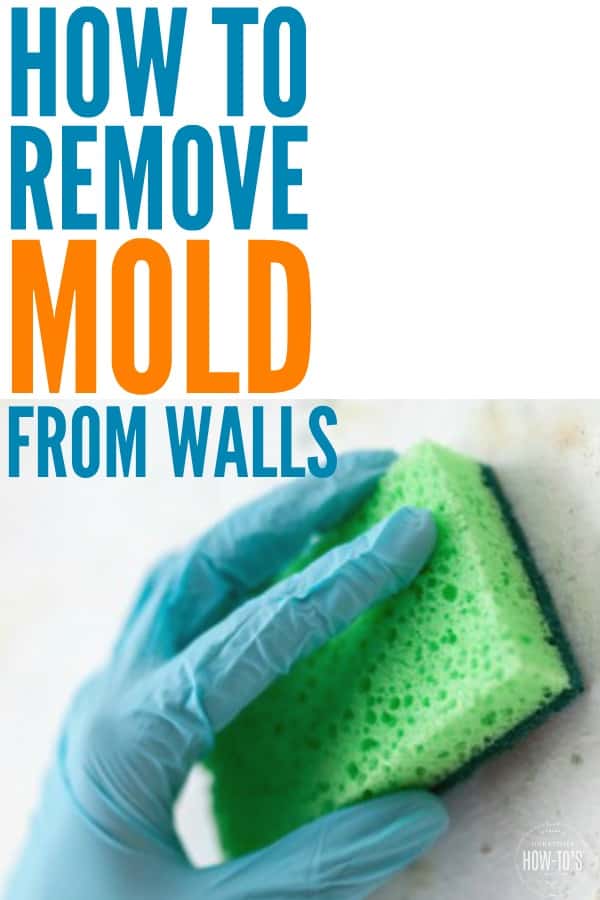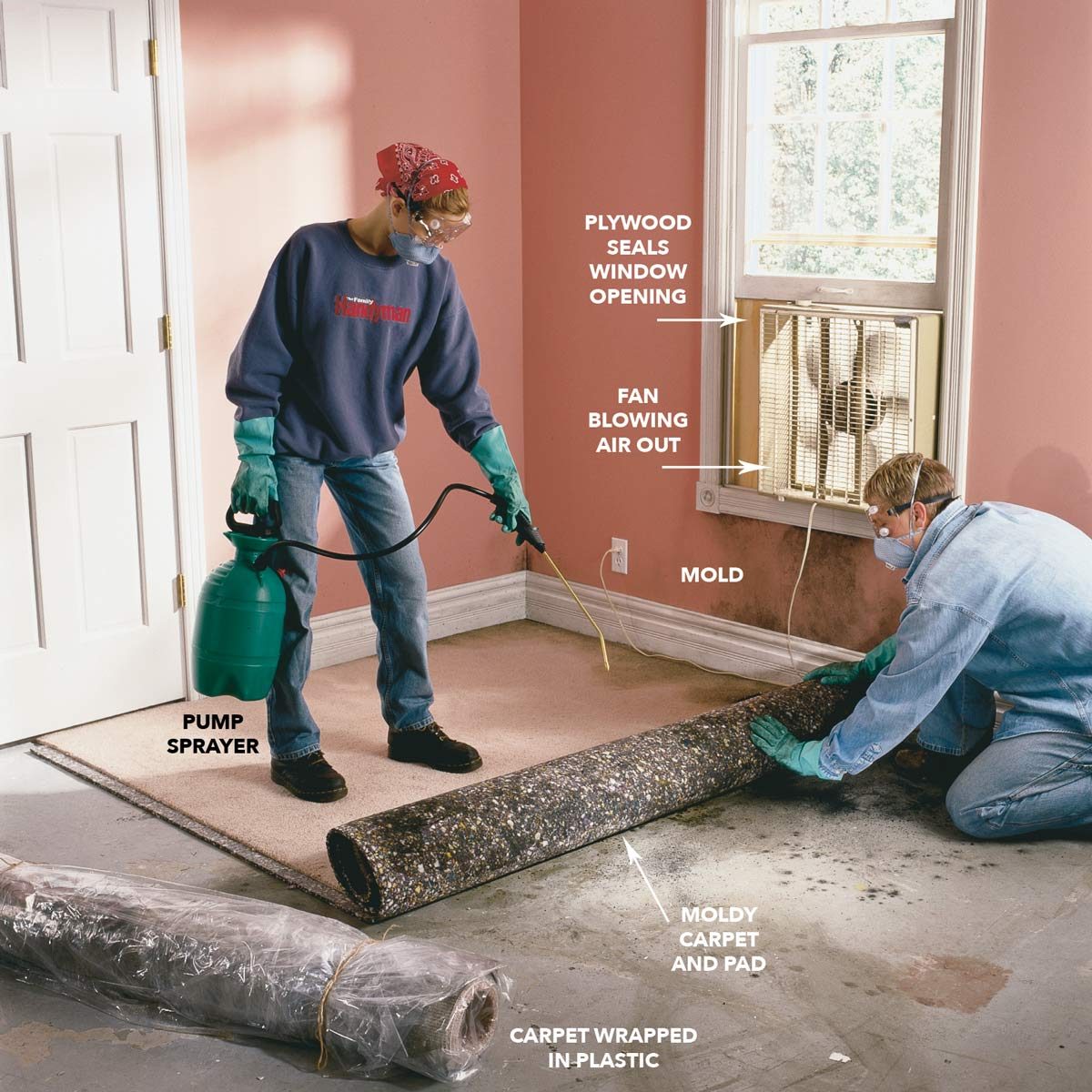Gather Equipment And Prep For Safety
First, you want to gather your cleaning tools and safety equipment.
Mold can trigger asthma and other allergic reactions in people who are sensitive to mold. For those people, it is best to avoid this activity.
Safety EquipmentFor safety equipment, you want to have gloves, a dust mask rated N95, and safety glasses.
If youre dealing with lots of mold, you will also want a Tyvex suit to protect the mold spores from getting on your clothes.
What Youll Need To Clean Mold
You have several options when it comes to what to use to sanitize the mold.
Hydrogen peroxide or OxiClean will work for generic cleanups. Scrub with a scrub brush.
If you want a deep clean, you can use what the professionals use. RMR-86 is a no-scrub formula.
For large moldy areas, you can use the 2.5 gallon size with a garden pump sprayer or professional spray bottle.
How To Eliminate Mold And Mildew In A Basement
Understand where this bad smell comes from and get rid of it for good with this four part plan. The musty smell in your basement, caused by the unfettered growth of mold and mildew, is also potential damage to the fabric in your home. Look for leaks in your basement that can lead to mold and mildew growth. Use a dehumidifier to reduce the humidity to less than 60 percent. Remove existing mold or mold spores. Neutralize musty odors in your basement.
Removing Mold From Tile Stone Concrete And Cement
Use the homemade bleach-based mold remover on hard surfaces. Spray the bleach-based mold remover until the area is saturated but not dripping wet. Scrub it with a rag, scouring pad, or brush and wipe away the residue. Lightly respray the area, wait 15 minutes, and then wipe the area with a fresh cloth dampened with water. Let the area dry overnight and inspect it the next day. Repeat if needed.
Recommended Reading: How To Clean Mold Off Granite Headstone
Removing Mold From Cinder Block Walls With Borax
Borax is a trustworthy and effective cleaner thats well-known for its cleansing and deodorizing properties. Since Borax inhibits mold growth, its an excellent cleaning solution for removing mold from cinder block walls and other large areas. You dont even need to clean it off when youre finished.
- Scrub brush or bristle brush
Before you use one of our ways to clean cement of mold or mildew, vacuum all your moldy surfaces with a HEPA-certified vacuum minimize the number of spores that end up airborne. Mix the Borax and water in a bucket to create your cleaning solution.
Scrub any moldy surfaces thoroughly and remove visible mold particles. Let the Borax solution sit on the surface for a little while if you dont wash it off, it will inhibit future mold growth. Use this solution to stop moss from growing on bricks outside, too.
Vinegar And Borax Are Safer

Two common household items can do the same job as bleach with less potential for adverse health effects are borax and vinegar. Borax is a mineral generally considered safe unless ingested, and vinegar is completely safe. Vinegar’s odor is unpleasant to some people, but the smell disperses quickly. You can use these cleaners separately.
Mix a cup of borax with a gallon of water and spray it on the mold, followed by a spray application of full-strength vinegar. You can also make a one-step spray solution by mixing 2 tablespoons of borax in a 1/4 cup of vinegar and adding 2 cups of warm water. Wait an hour after application, then wipe the walls down again with a clean damp cloth.
Recommended Reading: How To Get Rid Of Airborne Mold In House
How To Get Rid Of Mold On Walls
As long as it only covers a small area, mold on walls is generally easy to get rid of yourself. You can use various household products. Popular effective options include borax, vinegar, baking soda, tea tree oil, bleach, and hydrogen peroxide.
However, if you have severe and widespread mold growth on your walls, its not quite as easy. Its actually potentially hazardous to remove it yourself. We advise that you contact a mold removal professional to get rid of mold in your home safely and effectively.
Keep In Mind
The process of getting rid of mold on walls essentially requires two important steps. First, youll need to control moisture in your home, and then youll need to kill the mold.
Scrub Moldy Surfaces With Mold Cleaner
- Scrub the surface mold stains from walls and wood trim with a mixture of one quart water and 1/2-cup bleach mold cleaner to kill the mold.
- Use a soft brush and work until signs of the mold disappear.
- After scrubbing the surfaces, allow the bleach solution to continue to penetrate the surfaces and dry.
- Wipe off, but DO NOT RINSE these surfaces.
- Set trim in direct sunlight to dry. Scrub concrete with TSP or automatic dishwasher detergent.
Don’t Miss: How To Clean Mold Off Bathroom Ceiling
Can I Paint Over A Treated Mold Damaged Wall
It is probably your question after finishing the mold removal phase, and yes, you can paint over your disinfected walls using paint with mold-resistant ingredients.
Its best to use encapsulating primer and paint to prevent the fungal properties from growing on the wood surface. However, ensure that the wood is completely dried before you encapsulate them.
How To Remove Mold From Painted Wall
Anyone that has a moisture of humidity problem in their home will end up having mold on the walls.
That is unless you took the right steps to fix the moisture problem.
If you have mold growing on your walls, like most people, you probably cleaned it with bleach or some other mold removal product.
However, to your surprise, it came back days later.
If the growth returned, you probably didnt fix the moisture problem correctly the first time around.
Mold growing on painted walls can be resilient.
If you fail to get rid of the moisture source, it will keep coming back no matter how many times you try to clean it or paint over it.
The regrowth happens because chemicals applied often will not penetrate deep below the surface where the roots continue to grow.
When the roots keep getting a constant moisture source, the mold continues to develop.
Applying mold removers is only a temporary measure and only stops mold development when the killing agent stays active.
Once the killing agent evaporates, the regrowth will just happen again and again. That is until you find and stop the moisture source.
Read Also: How To Kill Mold In My Basement
Are There Any Natural Remedies For Removing Mold
If you’re looking for a natural solution to remove mold, one of the below options will work. Keep in mind, though, that they may take more time than bleach and may not remove stains:
- Hydrogen peroxide: Grab a spray bottle and pour 3% solution of hydrogen peroxide into the bottle. Spray the affected area, let it sit for 10 minutes, and then scrub the mold away.
- Vinegar: Pour undiluted vinegar into a spray bottle and spray the moldy area. Let it sit for an hour and then wipe the area clean with water and allow it to dry.
Cleaning Mold From A Painted Wall With No Water Damage
The first step in cleaning moldy walls or ceiling areas is to take the appropriate safety precautions.
While mold may not affect everyone, some individuals can have adverse allergic reactions to even small amounts of mold exposure.
Individuals like infants, elderly, persons with weak immune systems, and people with chronic respiratory problems.
If you plan to clean molds, even small amounts found in your home, take the right safety precautions. Make sure you wear gloves, N95 mask, and eye protection.
After you fix the moisture problem, do a visual inspection to see how much of the wall is affected.
Things You Will Need:
- Goggles for eye protection
- Dry cloth
This cleaning method is for removing molds from walls and ceiling areas affected by surface growth only.
Not for areas where drywall and components are damaged by mold and moisture.
Before starting the process, put on your gloves, mask and eye protection.
Also Check: How To Clean Mold Off Of Leather
Removing Mold From Painted Or Wallpapered Walls
For mold on painted walls, try a natural remover like white vinegar, borax and water. Youll need a spray bottle and a few other items to scrub the walls.
- Combine two tablespoons of borax with 1/4 cup white vinegar and two cups of hot water in a bowl.
- Pour into a spray bottle
- Liberally apply on painted walls.
- Scrub thoroughly and wipe clean, then spray again and let sit for 10 minutes before wiping dry.
How To Use A Dehumidifier:

Different dehumidifiers have different capacities, so factor in the size and humidity of your room before you choose one.
Set up the dehumidifier in the dampest area of the house, like the bathroom or the basement
Consult your chosen dehumidifierâs manual for specific instructions
Set the dehumidifier with your ideal humidity level: this should be between 40% and 60%.
Be aware that the first few cycles that your dehumidifier goes through will be removing more humidity than later cycles: at first, it will be removing excess water that has built up over a certain period of humidity, whereas once it is running regularly it will be collecting lighter amounts of water to maintain an ideal humidity level
Also Check: Cleaning Mold On Bathroom Ceiling
How To Remove Mold From Walls And Ceilings
The bad news: If the surface is very porous, like a ceiling tile, it’s best to replace it. The good news: If you find small areas of mold on walls or ceilings of sheetrock or plaster, you can stop mold when it starts if you act fast. Here’s how:
- Clean the surface with detergent and water using a sponge or brush and let the surface dry completely.
- Follow with a water and bleach solution: Mix ¾ cup of chlorine bleach to a gallon of warm water. Wearing rubber gloves, apply the water-bleach mixture to the stains with a sponge or brush.
- Let sit five minutes, scrub, rinse, and air dry.
Question 1 Of : Can I Remove Mold And Mildew Myself
You May Like: How To Clean Mold From Leather
Question 4 Of : How Do I Clean Mold And Mildew Off Of Wood
Why Do I Have Mould On The Walls In My Bedroom
Having mould on the walls in your bedroom can be a real problem. Bedroom mould is usually caused through condensation or high humidity, normally from weather conditions. It can be caused by poor ventilation and moisture in the air. Be sure to check cracks in windows or drainpipes which could be causing a build-up of moisture.
Don’t Miss: How To Clean Mold Between Pavers
Getting Mold Off Of Wooden Walls
Is White Vinegar To Remove Mold From Painted Walls
Does vinegar remove mold from painted walls? Its the most common query in the mind of many people. Well, yes. Here is how you can eliminate mold from painted walls using vinegar:
1. Combine white vinegar with warm water and apply the solution to the affected region.
2. Scrub, wash with clean water, and make the region dry using a towel.
3. Now, use a sponge soaked in a mild dishwashing liquid and warm water to get rid of debris and dirt from the wall.
You May Like: How To Clean Mold Off Canvas
More Drastic Measures For Treating Mildew
If mildew still persists even after youve treated your bathrooms surfaces repeatedly with white vinegar and baking soda, its time to take more drastic measures to eradicate the mildew. You can start by putting some hydrogen peroxide in a spray bottle, spraying the remaining mildew and scrubbing the treated area.
When hydrogen peroxide and white vinegar are combined, the results can be toxic. For this reason, its critical to exercise extreme caution and avoid combining these things or using the same spray bottle to treat mildew with white vinegar and hydrogen peroxide.
If hydrogen peroxide isnt enough to rid your bathroom of persistent mildew, you can treat the affected areas with a solution of bleach and water. This solution should be 75 percent water and 25 percent bleach. Just like you shouldnt combine hydrogen peroxide with white vinegar, avoid combining bleach with other cleaning agents. Youll also want to put on protective gloves before you treat the mildew in your bathroom with your bleach/water solution.
Mildew is generally pretty easy to treat. If you have any tips for treating mildew with common household items, we encourage you to share them in the comments section below!
Is Bleach Or Vinegar Better To Kill Mold

Vinegar outperforms bleach for killing mold on porous surfaces. Bleach is an effective surface disinfectant, but the chlorine in household bleach does not sink into surfaces. Bleach is a strong base that is caustic and noxious and has the potential to discolor or degrade the condition of some treated materials.
You May Like: What Causes Mold On Ceiling In Bathroom
Removing Mold From Different Rooms
Some rooms are more prone to mold than others. Bathrooms are notorious for mold growth because they harbor damp, humid environments that mold loves. Less frequented rooms such as basements and attics can also suffer from mold, which can go unchecked for a long time before being noticed. Heres how to prevent mold from taking hold in each room of your property.
Why Does Mold Grow On Concrete
Two main reasons trigger mold growth: moisture and food. The dust particles and other organic material on the wall can act as a nutrient source for molds and mildew. If your house is often cleaned and there is only a minimal amount of dust in the atmosphere, it lowers the risk of mold growth.
On the other hand, moisture is harder to deal with. There are two ways in how it can foster molds in your concrete block walls.
Read Also: What Causes Mold On Ceiling In Bathroom
